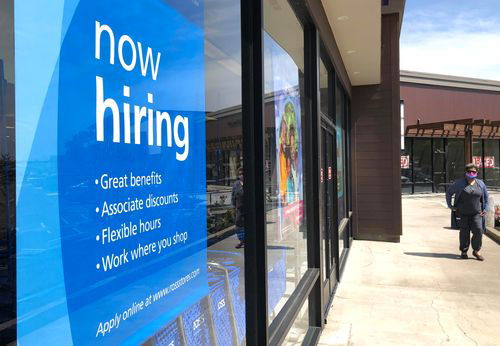Major disappointment: America added way fewer jobs than expected in April

Watch President Biden address the jobs report in the player below.
The pandemic continues to roil America's economy, setting the job market on its head. Employers looking for workers are having trouble finding them, while many laid-off Americans remain on the sidelines waiting for a return to normal. It's a confusing mess that's confounding employers and economists alike.
The US economy added only 266,000 jobs in April on the anniversary of the worst job loss for any month on record. That was far less than forecasts of economists, who had predicted America would add 1 million jobs last month.
The unemployment rate rose to 6.1% in April, up from 6% a month earlier, as more people returned to the labor force to look actively for work, the Bureau of Labor Statistics said Friday. The March jobs numbers were also revised down to 770,000 from 916,000 reported initially.
It was the slowest improvement for jobs since January. Experts predicted that the vaccine rollout and the reopening of the economy would jolt hiring.
In normal times, adding 266,000 jobs in one month would be a solid performance. But nothing is normal in this pandemic era, and America is still down 8.2 million jobs versus February last year before the Covid-19 hit. The disappointing April jobs number shows the road to recovery from the pandemic remains bumpy.
But the labor market isn't necessarily in trouble.
As analysts come to terms with how wrong their forecasts were, they point to other data like weekly claims for unemployment benefits as proof that improvements are continuing: Last week, jobless claims dropped below 500,000, a new pandemic-era low.
"With most of the high-frequency indicators still pointing to further improvement and jobless claims falling like a stone in recent weeks ... we doubt that it signals the recovery is at risk," said Capital Economics senior US economist Michael Pearce.
At this point, it's not clear how much weight this report deserves in the grand scheme of things, Pearce said. A decent May jobs report could render the April disappointment a temporary blip. But it makes clear that that the labor market recovery is lagging behind the boom in consumer spending.
A changing labor market
The job market also isn't just snapping back to what it was before Covid-19. The dislocations across different industries and worker demographics has been too big to recover from while Covid-19 continues to infect tens of thousands of people every day.
Lower-income earners, women, Hispanic and Black workers bore the brunt of the pandemic layoffs and millions remain out of work. Yet some industries can't find workers. That may seem contradictory, but it is proof that the job market is changing under the force of the pandemic.
Industries reliant on social interactions are still rebuilding after shuttering completely last year. The hospitality and leisure industry added 331,000 jobs last month — and more than half of that increase was positions at restaurants and bars, underscoring how beneficial the rollback of pandemic restrictions is for the industry. Yet, it is still down 2.8 million jobs compared to pre-pandemic times.
Meanwhile, factories and manufacturers have trouble finding specialized and even entry-level workers as employees worry that those jobs could be sent overseas or replaced by robots.
"The details of the data show signs that the pool of available labor is extremely tight," wrote Jefferies economists Thomas Simons and Aneta Markowska in a note to clients.
Manufacturing employment declined by 18,000 jobs last month. Other areas that registered job losses were temps in business services, couriers and retail. Seasonal factors, as well as shortages could have been the reason, according to PNC chief economists Gus Faucher.
Meanwhile, average hourly earnings jumped 21 cents to $30.17 last month. That was more than economists expected, and it suggests "employers are turning to higher wages to entice workers off of their couches and also asking current employees to work longer to cover scheduling gaps," said Simons and Markowska.
The average workweek increased by 0.1 hour to 35 hours last month. In manufacturing the average hours worked per week stood unchanged at 40.5 hours.
--Matt Egan contributed to this report.